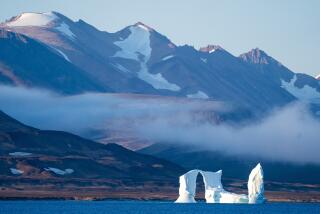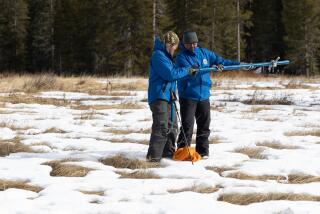No ice in Barrow, Alaska: Arctic ice shrinks to record low
BARROW, Alaska — Here at the top of the world, the news that Arctic sea ice has reached a new low — the smallest footprint since satellites began measuring it three decades ago — is not much of a surprise.
The Arctic seas off the Alaska coast have been increasingly ice-free in recent years. On Monday, the gray, wind-driven surf churned vigorously along the northern coast, with no sign of ice anywhere under the low, fog-shrouded skies.
But it has been a strange summer here. Until a few weeks ago, there was more ice spread across the near-shore waters of the Beaufort and Chukchi seas than anyone can remember for the last several years — a curse for the engineers waiting to begin plumbing oil wells into the sea floor, but a blessing for Inupiat hunters, who have had an unusually easy time catching seals from ice floes close to home.
“It really seemed kind of like it was back in the days when the ice was like it used to be,” said Nayuk Leavitt, a Barrow resident who works on one of Shell Alaska’s oil spill response crews.
But the late-lingering near-shore ice in Alaska, now in full retreat, was not representative of what is going on most everywhere else in a gradually melting Arctic, scientists say. The National Snow and Ice Data Center in Colorado announced that Arctic sea ice had shrunk to 1.58 million square miles, the lowest expanse recorded since satellites began taking measurements in 1979.
That breaks a record of 1.61 million square miles set in 2007, and the shrinkage appears to be continuing: Ice is expected to keep melting through September.
Scientists said previous warm years had started a pattern of a melting of the multi-year ice that historically has clung to the poles. The newly thinner ice that remained from last year melted even easier this year — although temperatures weren’t necessarily warmer. The phenomenon is probably feeding on itself, scientists say.
“In the context of what’s happened in the last several years and throughout the satellite record, it’s an indication that the Arctic sea ice cover is fundamentally changing,” Walt Meier of the National Snow and Ice Data Center told reporters in a conference call.
The unusually high accumulation of ice into the summer months off the coast of Alaska, probably caused by a combination of wind patterns and the cyclical rotation of ice around the North Pole, meant uncommonly good hunting for many families in Barrow, the highest populated point in the U.S., and nearby communities. Residents here say the marine mammals they depend on for food and fur were in many cases perched throughout the early summer unusually close to home, on the near-shore sea ice.
“All my family are hard-core hunters, so they’re just happy it was staying in, so they could get all their hunting done,” said Tim McCoy, a Barrow resident.
In Wainwright, on the northwest coast of the Chukchi Sea, ice lingered close to shore until late July, said Ian Wiley, who works at one of Shell’s camps on the coast. “Up until our last hitch here four weeks ago, you could see the sea ice right outside the camp,” he said.
Although the late-lingering ice was a factor in delaying the start of the first offshore drilling here in more than two decades, Shell officials say the ice now has retreated to more than 20 miles north of the company’s primary drilling target, on the Berger prospect in the Chukchi Sea — which itself is about 70 miles offshore.
The first of Shell’s drilling rigs, the Discoverer, is scheduled to arrive in the Chukchi Sea later this week. The other, the Kulluk, is halfway on its journey to the Beaufort Sea.
Permanent anchors have already been installed at both drilling locations to allow for the reduced target of drilling two complete wells this season, Shell spokesman Curtis Smith said in an interview here.
Shell has asked the Bureau of Ocean Energy Management to consider extending by 18 days the Sept. 24 deadline under which the company was supposed to have completed drilling in the Chukchi Sea, where the relatively remote location requires an early wind-up to ensure there is time to address any problems that occur before the onset of winter ice.
But Shell’s own ocean ice experts say their latest modeling makes them fairly confident that ice is not likely to close in around the Chukchi drilling site until mid-November.
The company has been spending $4.5 million a year on ice studies, assembling a team of scientists whose expertise rivals or exceeds that of the National Weather Service.
They have documented a pattern of ice movements over the last 10 years that show predictable open ocean conditions in the Chukchi Sea until November every year, Shell’s chief scientist, Michael Macrander, told the Los Angeles Times.
He said 2006 is the year that most resembles the patterns seen this year: a winter of cold temperatures and heavy ice, in which the sea ice extended far south into the Bering Strait, followed by a very late melt-off in the summer. That year, like this one, saw factors such as warm surface temperatures and favorable winds that drove the ice, once it was beginning to clear, relatively far out to sea, he said.
“Once it cleared, it cleared significantly, and stayed clear until early November,” he said. “And the pattern we’re seeing now is very, very similar.
“I stress this is not just Shell recognizing this. This is the national ice center, among others. There’s a convergence of thought on this,” he added. “What we are predicting is about a mid-November closure, if you will, being the formation or encroachment of new ice at Berger prospect around Nov. 15, and we put a window of error from the 12thto the 18th. That is our best estimate at this point.”
Robert Raye, an ocean ice expert also working for Shell, said the forecast assumed not only the parallels to 2006, but what had happened every year in the last 10.
“The earliest day [for ice onset near the Berger prospect] in the past 10 years was Nov. 3,” he said.
Shell officials have agreed they would not attempt to drill deeper into hydrocarbon zones past the original Sept. 24 deadline set by the federal government for the Chukchi Sea, but argue they should be allowed to keep the well open and to work on adjoining areas until Oct. 12.
Drilling is already allowed until Oct. 31 at Shell’s closer-in drilling site on the Beaufort Sea.
Conservation groups said Monday’s announcement of a record retreat in sea ice should reinvigorate efforts to halt the pace of climate change, which most scientists believe is contributing to the accelerated loss of sea ice.
“This is a profound — and profoundly depressing — moment in the history of our planet,” Shaye Wolf, climate science director at the Center for Biological Diversity’s Climate Law Institute, said in a statement.
“It used to be that Arctic ice melt was something that was in the model prediction, but now we see not only that the reality is upon us, but that it is even more extensive than projected,” Rafe Pomerance, a former climate negotiator and deputy U.S. secretary of State, said in a news release. He called for new efforts to achieve reductions in greenhouse gas emissions.
The loss of heat-reflecting sea ice is triggering a cycle of even warmer temperatures, Pomerance said. “Its loss will mean a much hotter world.”
ALSO:
A never-read eulogy of Neil Armstrong
‘American Taliban’ fights for the right to group prayer
Isaac takes aim at New Orleans, just seven years after Katrina
More to Read
Sign up for Essential California
The most important California stories and recommendations in your inbox every morning.
You may occasionally receive promotional content from the Los Angeles Times.










